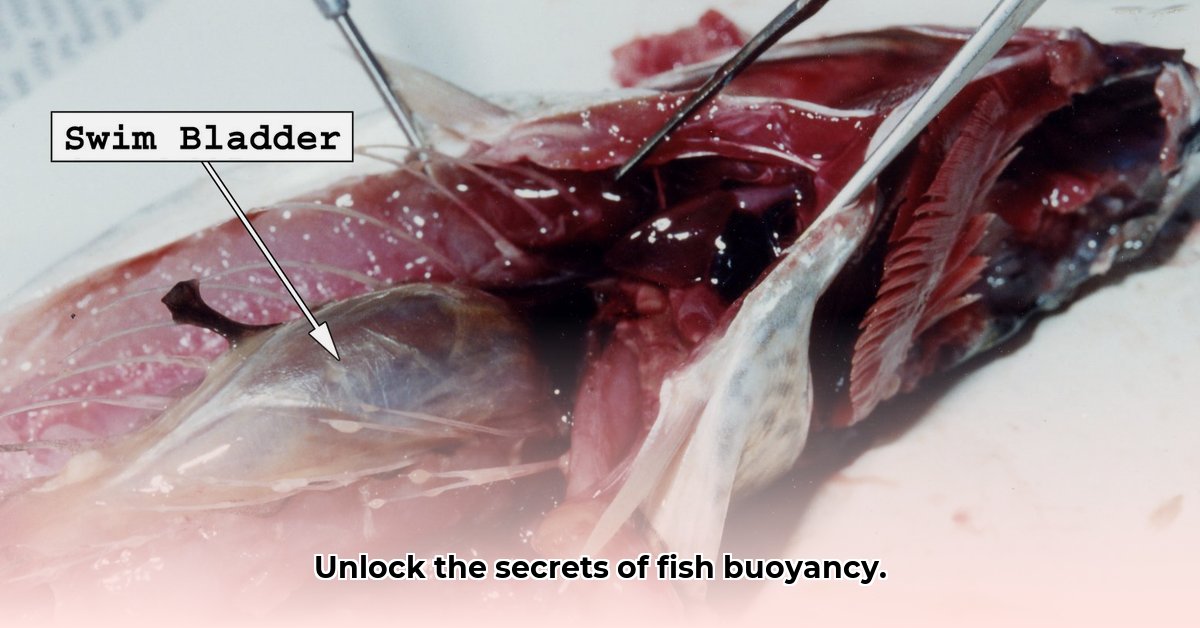Ever wonder how fish maintain their depth effortlessly? This review explores the gas bladder, an internal organ enabling fish to adjust their buoyancy. We delve into the variations in gas bladder types, their role in hearing and sound production, and their importance in fish conservation and aquaculture. This article synthesizes current knowledge, identifies research gaps, and offers insights for researchers and practitioners working with fish, covering buoyancy regulation, hearing enhancement, and the impact of barotrauma.
Gas Bladder: The Amazing Internal Float of Fish
The gas bladder, also known as the swim bladder, is an organ found in many bony fishes that allows them to control their buoyancy and depth without constant swimming. By adjusting the amount of gas in the bladder, fish can change their density and move vertically in the water column. The design and function of the gas bladder can vary significantly depending on the fish species and its environment. This enables fish to thrive in diverse aquatic habitats from shallow ponds to the deep ocean.
Two Types: The Duct-Equipped and the Ductless
There are two primary types of gas bladders: physostomous and physoclistous. Physostomous gas bladders have a direct connection, or pneumatic duct, to the esophagus, allowing the fish to gulp air to inflate the bladder. Excess gas can also be expelled through this duct. This method is suitable for fish in shallow waters where surface access is readily available. Physoclistous gas bladders, on the other hand, lack this direct connection. Instead, they rely on specialized tissues, such as the gas gland and the oval, to secrete and absorb gases from the bloodstream, providing more precise buoyancy control, especially in deep-water environments. The gas gland secretes gas into the bladder, while the oval reabsorbs it back into the blood. This closed system allows for fine-tuned adjustments without the need to surface.
Beyond Buoyancy: The Gas Bladder’s Hidden Talents
Besides buoyancy control, the gas bladder performs additional functions. In some fish, it aids in respiration by extracting oxygen from the water (acting as a supplemental respiratory organ), particularly in oxygen-poor environments. It also serves as a sound amplifier, enhancing both sound production and hearing, crucial for communication, predator avoidance, and navigation. Some fish have a Weberian apparatus, a series of small bones that connects the gas bladder to the inner ear, significantly increasing their hearing sensitivity and range. This adaptation is particularly common in freshwater fish. The gas bladder is a multi-tasking marvel.
Evolutionary History: From Lungs to Buoyancy
The gas bladder is believed to have evolved from the lungs of early lobe-finned fishes, which were ancestors to both modern fish and land vertebrates. This ancestral lung transformed from an organ for breathing air into a buoyancy control device in most ray-finned fish, illustrating evolutionary adaptation to aquatic life. The variations in gas bladder structure across different fish species reflect adaptations to diverse aquatic environments. Some fish, like sharks and rays, lack a gas bladder, relying on other mechanisms for buoyancy control, such as constant swimming, oily livers (rich in squalene, a low-density lipid), and specialized fin structures that provide hydrodynamic lift.
Gas Composition and Regulation
The composition of gas within the swim bladder varies depending on the fish species and its habitat. In shallow-water fish, the gas composition is similar to atmospheric air, while deep-sea fish often have a higher concentration of oxygen to counteract the effects of high pressure. The process of gas secretion and reabsorption is tightly regulated by the fish’s nervous and endocrine systems, ensuring that buoyancy is maintained even during rapid changes in depth.
Unanswered Questions: The Ongoing Investigation
Despite significant knowledge regarding gas bladders, mysteries remain. Scientists continue to investigate the precise mechanisms of gas exchange in physoclistous bladders, particularly the role of various hormones and enzymes involved in gas secretion and reabsorption. The gas composition within these bladders, and how it varies across species and habitats, is still an area of active research, especially in extreme environments like the deep sea. The efficiency of gas secretion and reabsorption in physostomous versus physoclistous types, and how these differences affect their ecological niches, also requires further study. The extent of the gas bladder’s contribution to respiration in different fish species is also being studied, revealing ongoing research opportunities.
Beyond the Fish Tank: Real-World Applications
Understanding gas bladder function is beneficial in preventing barotrauma in deep-sea fish caused by rapid pressure changes encountered during capture and release, common in commercial fishing. This knowledge informs the development of techniques to minimize injury, such as using weighted lines to reduce ascent speed and employing release mechanisms that allow fish to return to their original depth gradually. The mechanics of the gas bladder inspire the development of buoyancy systems for underwater vehicles and robots, improving underwater movement and stability for exploration and research purposes.
Future Directions: What Lies Ahead?
The research into gas bladders continues, with key research goals outlined in the table below:
| Stakeholder Group | Short-Term Research Goals (0-1 year) | Long-Term Research Directions (3-5 years) |
|---|---|---|
| Ichthyologists/Researchers | Detailed studies on specific gas bladder functions within various fish families and species, focusing on previously understudied taxa. | Extensive comparative genomic and functional studies across a diverse range of fish species, including gene expression analysis during gas bladder development and function. |
| Veterinarians/Aquaculturists | Improved methods for diagnosing and treating gas bladder-related ailments in fish, with an emphasis on non-invasive diagnostic techniques. | Optimizing husbandry techniques for fish species with different gas bladder types and needs, including dietary modifications to improve gas bladder health. |
| Biomedical Engineers | Developing bio-inspired buoyancy technology based on the design of various gas bladders, focusing on energy efficiency and miniaturization. | Producing enhanced underwater robots and devices optimized for various marine environments, including robots capable of mimicking fish buoyancy control for stealth and maneuverability. |
| Evolutionary Biologists | Using genomic data to track gas bladder evolution and its adaptation to different aquatic habitats, with a focus on identifying key genes involved in gas bladder development. | Developing models predicting gas bladder function changes in response to environmental stressors like climate change, including the effects of ocean acidification on gas bladder physiology. |
| Conservation Biologists | Assessing the impact of anthropogenic noise on gas bladder function and hearing in fish populations. | Developing mitigation strategies to minimize the impact of human activities on fish populations, including noise reduction measures and habitat restoration efforts. |
The gas bladder is a significant organ with various functions, including buoyancy regulation, respiration, and sound production. As research advances, more insights will be gained about its role in aquatic ecosystems.
How do different gas bladder types affect fish buoyancy control?
Key Takeaways:
- The swim bladder is vital for buoyancy in bony fishes, showcasing structural diversity that impacts function.
- Physostomous (open) and physoclistous (closed) bladders have unique gas regulation mechanisms, influencing buoyancy efficiency.
- Cartilaginous fishes lack swim bladders, using alternative adaptations.
- Environmental factors significantly affect swim bladder capabilities, requiring adaptation.
- Research focuses on barotrauma and release methods for commercially caught species to address the physiological impacts of rapid ascent.
- Further studies are needed to explore evolutionary transitions from physostomous to physoclistous bladders within varied aquatic niches.
- Recognizing energy demands of diverse buoyancy tactics is vital for successful species conservation.
The Swim Bladder: A Masterpiece of Hydrostatic Control
Fish use adaptations to move through water, and the swim bladder is a hydrostatic organ responsible for regulating buoyancy. Understanding how different gas bladder types impact buoyancy control is vital. The answer lies in structural and functional variations across fish species. For example, some fish species can adjust the gas volume in their swim bladder within minutes, while others take hours or even days.
Physostomous vs. Physoclistous: A Tale of Two Bladders
Two main types exist: physostomous and physoclistous. Physostomous bladders, found in more primitive bony fishes, have a pneumatic duct connecting the swim bladder to the esophagus, allowing direct gas exchange with the atmosphere. This allows the fish to gulp air to inflate the bladder or release air to deflate it. Physoclistous bladders, found in more advanced bony fishes, lack this duct. Gas exchange involves blood vessels known as the rete mirabile (meaning “wonderful net”), a network of capillaries that allows for efficient gas transfer between the bloodstream and the swim bladder.
The Buoyancy Balancing Act: Pressure and Depth
Boyle’s Law states that gas volume is inversely proportional to pressure. As a fish dives, pressure compresses the swim bladder, and ascending causes expansion. Physoclistous bladders are better suited to cope with pressure changes at depth due to their fine-tuned gas exchange system, whereas physostomous fish face challenges in maintaining neutral buoyancy at greater depths and must frequently surface to adjust their gas bladder volume.
Beyond Bony Fish: Alternative Buoyancy Strategies
Cartilaginous fishes, such as sharks and rays, lack swim bladders and use alternative mechanisms such as oily livers, heterocercal tails (where the upper lobe is larger than the lower lobe), and constant swimming to generate lift. These solutions showcase adaptive strategies in the aquatic world, highlighting the diversity of buoyancy control mechanisms in different fish groups.
Environmental Influences and Conservation Implications
Environmental factors like temperature and salinity influence gas solubility in water, affecting
- Master Parts of Pants:Perfect Fit Guide - June 14, 2025
- Unlock Your Vinyl: Parts of a Record Player Guide - June 14, 2025
- Shop Authentic Southwestern Clothing: A Guide - June 14, 2025
















